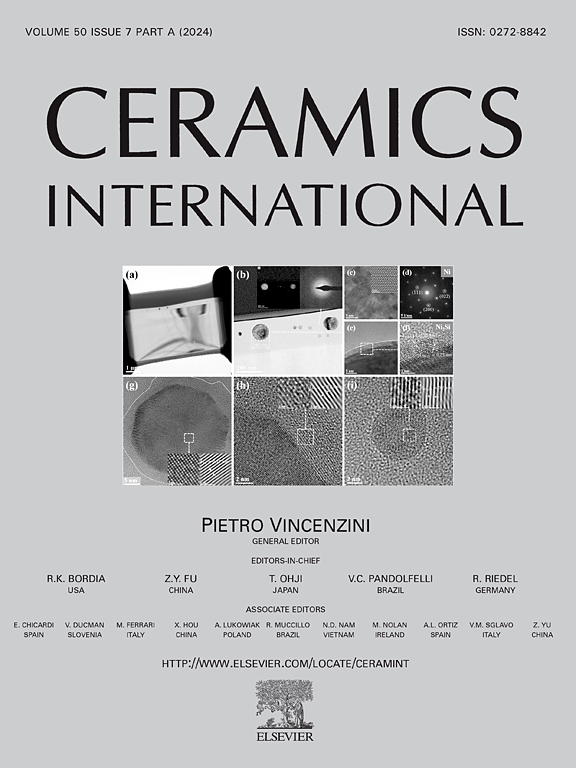掺f的CaO-Gd2O3-CeO2固体电解质高离子电导率机理研究
IF 5.6
2区 材料科学
Q1 MATERIALS SCIENCE, CERAMICS
引用次数: 0
摘要
CeO2是一种很有前途的中温固体氧化物燃料电池(IT-SOFCs)电解质。研究发现,f掺杂提高了其离子电导率,但其潜在的机制尚不清楚。因此,本研究采用DFT + U方法计算Gd、Ca和f共掺杂CeO2的几何结构和电子结构以及氧离子迁移。通过实验验证了计算结果。DFT计算发现,与Gd和ca掺杂的CeO2不同,氧空位(V)很容易在F−离子附近的相邻位置形成。Gd-、Ca-和f -掺杂增强了Ce-O键,这与报道的f掺杂实验假设的结果不一致。f掺杂抑制了Ce4+向Ce3+的转变。氧离子的迁移能垒Em主要受迁移距离的影响,其次受氧空位空腔大小和缺陷关联的影响。由于cof和CGOCF中氧空位空腔尺寸更大,缺陷关联更小,F掺杂的Em更小。这与报道的实验研究基于F和o的电负性比较的推测相反。我们的实验发现,Ca和F共掺杂显著提高了CeO2的电导率,是gd掺杂CeO2的3.9倍。该研究阐明了掺杂CeO2中离子电导率的本质机制,为开发高性能CeO2基电解质提供了原子水平的见解。本文章由计算机程序翻译,如有差异,请以英文原文为准。
Mechanism study of highly ionic conductivity for F-doped CaO-Gd2O3-CeO2 solid electrolyte
CeO2 is a promising electrolyte for intermediate-temperature solid oxide fuel cells (IT-SOFCs). Studies have found that F-doping improves its ionic conductivity, but the underlying mechanisms remain unclear. Therefore, this study employs a DFT + U method to calculate geometrical and electronic structures and oxygen ion migrations of Gd-, Ca- and F-dopings co-doped CeO2. The calculated results are verified by our experiment. DFT calculations find that oxygen vacancies (V) are easily formed at next-neighboring sites near the F− ions, different with the case of Gd- and Ca-doped CeO2. Gd-, Ca- and F-dopings strengthen Ce-O bonds, inconstant with the result from the reported experimental hypothesis for the F-doping. The F-doping restrains the change of Ce4+ to Ce3+. Migration energy barriers Em of oxygen ions are mainly affected by the migration distances and peripherally done by the oxygen vacancy cavity size and the defect association. Due to the lager oxygen vacancy cavity size and the smaller defect association in CGOF and CGOCF, the F-dopings have the smaller Em. This is contrary to the speculation of the reported experimental study based on the electronegative comparison of F and O. Our experiment finds that Ca and F co-doping significantly increases the conductivity, 3.9 times of the conductivity of Gd-doped CeO2. The study clarifies the nature mechanism of the ionic conductivity in doped CeO2, offering atomic-level insights to aid the development of high-performance CeO2-based electrolytes.
求助全文
通过发布文献求助,成功后即可免费获取论文全文。
去求助
来源期刊

Ceramics International
工程技术-材料科学:硅酸盐
CiteScore
9.40
自引率
15.40%
发文量
4558
审稿时长
25 days
期刊介绍:
Ceramics International covers the science of advanced ceramic materials. The journal encourages contributions that demonstrate how an understanding of the basic chemical and physical phenomena may direct materials design and stimulate ideas for new or improved processing techniques, in order to obtain materials with desired structural features and properties.
Ceramics International covers oxide and non-oxide ceramics, functional glasses, glass ceramics, amorphous inorganic non-metallic materials (and their combinations with metal and organic materials), in the form of particulates, dense or porous bodies, thin/thick films and laminated, graded and composite structures. Process related topics such as ceramic-ceramic joints or joining ceramics with dissimilar materials, as well as surface finishing and conditioning are also covered. Besides traditional processing techniques, manufacturing routes of interest include innovative procedures benefiting from externally applied stresses, electromagnetic fields and energetic beams, as well as top-down and self-assembly nanotechnology approaches. In addition, the journal welcomes submissions on bio-inspired and bio-enabled materials designs, experimentally validated multi scale modelling and simulation for materials design, and the use of the most advanced chemical and physical characterization techniques of structure, properties and behaviour.
Technologically relevant low-dimensional systems are a particular focus of Ceramics International. These include 0, 1 and 2-D nanomaterials (also covering CNTs, graphene and related materials, and diamond-like carbons), their nanocomposites, as well as nano-hybrids and hierarchical multifunctional nanostructures that might integrate molecular, biological and electronic components.
 求助内容:
求助内容: 应助结果提醒方式:
应助结果提醒方式:


